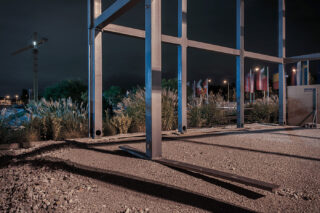V
These narratives with no anchors to era can remind one of theatrical sets, their stages devoid of humans. These are cinematic-like presentations. By revealing objects and detail with light, Markus becomes a masterful engineer much like a lighting technician for the theater is able to create focus and drama. Markus’ stages are constructed so we might visually wander effortlessly from front to back in deep investigation. Set-design techniques, like exaggerated perspective, and multiple light sources to tell selected stories all come to bear upon this work. The balance of foreground and background is often of equal emphasis. Everything in the frame is important, and we are left to decide which elements are the most interesting. More often than not, however, it is everything. Rarely is there one central object that demands prominence. Once again, we see this additive layering at play: The details and elements he builds create a greater whole—a harmonious tapestry of interest to which the viewer decides what is important.
This is contemplative work. It is far from portraying a daily collection of human moments, and it steers clear of any photographic cliché or common subject matter. The supreme achievement of these images is their duality of purpose: They are about not only a place but also us, as people. Much like Atget’s relationship with Paris, Markus’ relationship with Berlin is decidedly modern and German. He is the right person from the right generation, at the right time to create these images. He has managed to catalog and capture the very essence of the evolution and tireless change of Berlin without the obvious workings or trappings of photojournalism. It is a catalog that transcends scientific description of time, function, and place. They are soft-spoken. I believe it was critical for Markus to have made these images in Berlin. It is a place where the energy is felt, and its history is top of mind and alive with transformation. To the viewer, though, it is not important to the viewing experience to know where these images were taken. You can feel the transformative energy in these works. These are images that are seductive in their beauty; wondrous in their timelessness. They make us keenly aware that there is mystery and surprise, every 24 hours of our lives in front of us, below us, and, more than likely, right around the next corner.
Ponder these images. They are quietly astonishing and seductive in their industrial beauty. Viewing them is like wandering down a dark hall and stumbling onto some great stage set for a magnificent performance that is yet to occur. If you are patient, you will come to understand that the performance will begin, eventually, when the workers and citizens of the city return to these places. And long after the nightingale has stopped singing, when the first sign of daylight appears in the eastern sky and the carbon arc lights power down, take comfort in knowing there will always be a dawn and it is filled with surprise and delight. For in our waking hours, when this photographer has gone home for the night, we will appreciate that we can still be newly introduced to the wonder of possibilities right in front of us.
Michael Tittel
Summer 2013, Cincinnati, Ohio


















